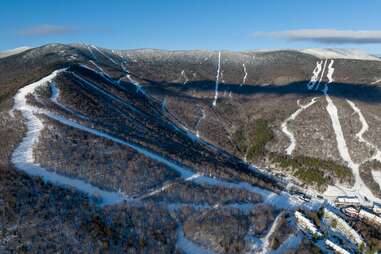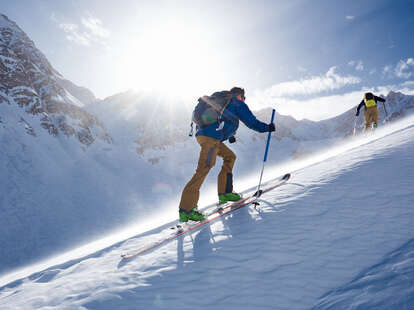Uphilling: It's How to Ski Free or Nearly Free All Season Long
From Vermont to Colorado, get into the growing ski trend that’s healthy, sustainable, and wayyy more affordable.
Do you want to ski Aspen all winter long without spending a liftload? You can—yes, it can be all yours for a small, one-time price of just $68.99. For less than a round of après drinks, you can ski every single day of the ski season. Skip the lift lines, clear your head, and get in a killer workout.
Sounds like a scam, right? It’s actually not—but you know, there’s just one thing. You need to ski uphill, to the top of the mountain, before schussing down. Quads and glutes, activate.
It may sound mind-blowing to many, but uphill skiing is not new—certainly not at Aspen, where it’s been possible for more than 75 years. But there has been an increase in interest the past couple years. The 2021–2022 National Ski Areas Association’s Kottke End-of-Season Survey Report found that 62% of U.S. ski areas allow uphill access. That’s a 30% increase from the 2012-13 season, when the survey first asked about uphill policies.
Uphill skiing is booming, and not just among ski mountain locals and uber athletes. The sport is gearing up to take to the biggest stage in the world, too. That’s right: the Winter Olympics. The 2026 Winter Olympics in Milan will have three medal events for ski mountaineering–or simply, skimo–a variation of uphill skiing that includes traversing ungroomed backcountry snow. Here’s what to know about uphilling and how to partake yourself, to ski for cheap all season.

What is uphill skiing?
But first, what exactly is uphill skiing? To be honest, it’s exactly what it sounds like. You ski up a slope, using skis equipped with “skins” that grip the snow to keep you from sliding backwards. You may also hear uphill skiing called other names, like uphilling, skinning, and alpine touring, as well as ski mountaineering (we know, it’s kind of confusing).
Where alpine touring and ski mountaineering are backcountry endeavors, uphill skiing or uphilling typically refers to going up the slopes on groomed trails only. There’s no forging new paths across untrodden powder.
Uphill skiing also differs from cross-country or nordic skiing, since you get to savor the thrill of a downhill run once at the top. Cross-country skiing is primarily done on somewhat flat terrain and small, rolling hills. The larger slopes of uphilling allow skiers to step out of the groomed tracks for the descent, making their own turns down the mountain. They also need to be able to have a free heel for the climb and then lock their back of boot to the ski for the big downhill (and we’ll get to gear in a moment).
Some say uphilling can be grueling, but really, it’s what you want to make it. “You’re in control of your own route,” says John Bleh, public relations & communications manager at Sugarbush Resort in Vermont. “You can go up as far as you want, then turn around when you’re ready.”

But seriously, why?
While interest in uphill skiing has been steadily growing, its popularity really took off during the pandemic. Everyone wanted to get outdoors, and many took to ski areas, but uphilling afforded skiers added freedom and extra distance (you know, six feet apart) from other skiers. With uphill skiing, there’s no waiting in crowded lift lines and no sharing gondolas up the mountain.
It’s also a great form of exercise and provides a sense of accomplishment for skiers who “earn their turns” by first skiing up to the top of a run. “It makes the run down that much sweeter,” adds Bleh. You’ll also stay a lot warmer, since trekking uphill will get your heart pumping, so you can ditch those hand and toe warmers.
Last season, more than 2,300 skiers requested a free uphill travel pass at Sugarbush to access uphill routes on Mt. Ellen and Lincoln Peak—a sizeable increase from 300 passes in 2016.
Many skiers also take to uphilling for the cost savings. Like, serious cost savings, even at ski areas that charge for uphilling passes, like Colorado’s Aspen Snowmass, which began charging $69 per skier last season for uphill access. Remember, this is $69 for an entire season. Compare that with more than $200 for just one day of downhill-only skiing and all-day lift access.
Uphill skiing is a fantastic way to be a sustainable skier, too. There’s a lot to love about tapping into human power rather than fossil fuels to reach the top of the mountain.

Where to ski uphill
Uphill skiing has become more accessible and easier to find, thanks to new uphill ski routes of varying steepness and length. Resorts and ski areas typically allow uphill access on select green (easy) and blue (moderate) runs. You’ll want to gradually wind your way up a mountain. A steep climb is not suggested, especially not for newbies.
Several ski areas have added new uphill routes, including Canada's Mont-Orford, Washington's Mt. Spokane and West Virginia's Snowshoe. Some others have increased uphill access, like Colorado’s Copper Mountain, which doubled the number of uphill routes from four to eight last season. Aspen Snowmass has 10 uphill routes across their four ski mountains.
Ski areas typically post uphill policies online, which can include allowed routes and operating hours for uphill travel. Some routes may only allow uphill access before and after general ski access, like 4 am to 7 am and 5 pm to 10 pm, which are the hours at Sugarbush’s Lincoln Peak.
A waiver is often required, too. “In the last 10 years, we’ve really solidified our uphill programming and policies,” says Katie Ertl, senior vice president, mountain operations, Aspen Skiing Company. “This is for the safety of both the uphill skier and the downhill skier.”
Aspen Snowmass offers a lot for all levels of uphill skiers, from private lessons and clinics, to race events for both recreational and elite athletes, such as America’s Uphill and Power of Four, which involves skiing up and down all four resort mountains.

What gear do I need to ski uphill
You can’t just head out to go uphill skiing with any old ski setup. For starters, you’ll need “skins” that attach to the bottom of your skis and grip the snow as you ascend the mountain. It’s just not going to work if you’re slip-sliding backward the entire time.
Specially-designed skis and boots are also required for uphill skiing, largely because you will need an unlocked heel (i.e., not fully locked in to the ski) to slide your skis up the mountain. You’ll also need to be able to lock in your boots when it’s time to schuss down the mountain.
“Uphilling has gained popularity as the equipment has gotten better for both elite endurance athletes and the recreational user,” suggests Adrienne Saia Isaac, director of marketing and communications at National Ski Areas Association. Thankfully, rental shops abound in ski towns, like Ute Mountaineer in Aspen, which rents skis, boots, poles, and skins for uphill skiing.
When you’re ready to ascend a mountain on skis, there’s a mountain that’s ready for you. Even better, many ski areas are rolling out events to get skiers excited about uphilling, like special dining events and gear demo days.
